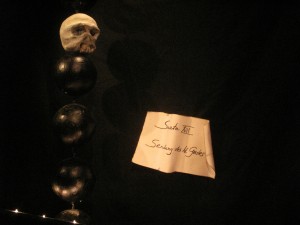
3 sonatas for violin and basso continuo from the Rosary Sonatas (1678) of Heinrich Ignaz Franz Biber. Marian hymns sung by mezzo-soprano Anna Clare Hauf. Texts on “The Plainacher Case – the Witch of Vienna” read by Julia Reichert. Tableaux Vivants.
In 1583, Elsa Plainacher—known as the “Witch of Vienna”—was burned at the stake on a field called the Gänseweid, located in Vienna’s present-day 3rd district. She was to be the city’s only witch-hunt victim, and her execution served as an entertaining spectacle for the general populace. The charges against her included cursing her granddaughter with 12,652 devils, which all the bishops and cardinals between Vienna and Maria Zell had attempted to exorcise from the little girl.
First and foremost, though, the Plainacher Case was the pawn of religious and political ambitions. At the emperor’s behest, the aged protestant woman was brought to Vienna from her home village of Mank near St. Pölten, tortured multiple times and ultimately executed.
One century later, Count Maximilian Gandolph von Kuenberg—Salzburg’s archbishop and cardinal, as well as head of the archbishopric’s Confraternity of the Rosary, had numerous brutal witch-hunts staged. Heinrich Ignaz Franz von Biber gifted and dedicated to the archbishop, his employer, a calligraphically executed manuscript of his Rosary Sonatas.
This context reveals the witch-hunt to be something of a negative corollary to the veneration of Mary, with the magical and seductive woman allied with Satan being painted as the opposite of the virgin and chaste bearer of God’s son.
Baroque violin: Lina Tur-Bonet
Voice: Anna Clare Hauf
Claviorganum: Eugène Michelangeli
Puppeteers: Michaela Mahrhauser and Jennifer Podehl
Stagecraft: Martin Kerschbaumer
Costumes and props: Burgis Paier
Stage Scenery: Ahmed Awad, Julia Reichert and Mike Wanzenböck
Text and stage direction: Julia Reichert